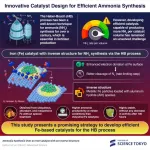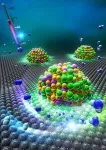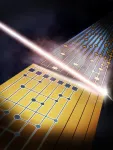Revolutionizing ammonia synthesis: New iron-based catalyst surpasses century-old benchmark
Innovative catalyst design generated automatically from rust with added aluminum achieves higher productivity and stability, paving the way for greener industrial processes
2025-01-24
(Press-News.org)
NH3 is one of the most important chemicals in today’s world, as it is used in the production of fertilizers to boost agricultural yields and sustain the ever-growing global population. For over 100 years, NH3 production has relied on the Haber–Bosch (HB) process, which combines nitrogen (N2) and hydrogen in the presence of a catalyst. Interestingly, an iron-based catalyst developed a century ago (called ‘Promoted-Fe’) still remains at the forefront of mass NH3 production, despite countless efforts to find more energy-efficient alternatives. In the HB process, where NH3 is produced by a catalyst-filled reactor with a limited volume, the NH3 productivity in the reactor depends on the NH3 production rate, not per catalyst weight but per catalyst volume. While the former looks like the latter at a glance, these two are completely different. No catalyst has ever been able to surpass Promoted-Fe in NH3 production rate/catalyst volume over the whole temperature and pressure ranges. For this reason, most academic researchers have chosen to ignore the fact and have compared the NH3 production rates/catalyst weight of “new catalysts” in academic journals; this competition would not lead to a significant improvement in the HB process.
Against this backdrop, a research team from Institute of Science Tokyo (Science Tokyo), Japan, has taken a bold step forward with an innovative approach towards catalyst design. As reported in their latest paper, which was published in the journal Advanced Science on January 23, 2025, Professor Michikazu Hara and colleagues took the design principles of established iron-based catalysts and essentially turned them into an innovative tool, achieving remarkable results.
Supported metal catalysts used for NH3 production typically consist of transition metal particles deposited on a support material with a large specific surface area and low density, which ideally increases the active surface area and enhances NH3 production rate/catalyst weight. However, this design results in a small NH3 production rate/catalyst volume because of the low density.
To tackle this issue, the research team from Science Tokyo designed and tested metal catalysts with an inverse structure. In other words, the proposed catalysts consisted of large iron particles loaded with an appropriate ‘promoter.’ “In the inverse catalyst design, highly active sites can spread outwards concentrically on the metal surface from the center of a deposited promoter,” explains Hara, “Nonetheless, it had not been verified which structure is more effective in increasing the NH3 production rate per catalyst volume—until now.”
After experimenting with various compositions, the research team settled on a catalyst consisting of aluminum hydride (AlH) and potassium loaded onto relatively larger iron particles (AlH-K+/Fe). The catalytic performance of this new material was outstanding in various regards. The NH3 production rate/volume of the catalyst reached ca. 3 times that for Promoted-Fe. Moreover, the proposed catalyst could also produce NH3 below 200 °C at which Promoted-Fe cannot work for NH3 production, as Hara highlights, “the new catalyst did not only exhibit much higher catalytic performance than Promoted-Fe that has never been surpassed by any catalyst developed so far but also synthesized NH3 even at 50 °C. Needless to say, the catalyst is stable. We have confirmed that the catalyst produces NH3 without any decrease in activity over 2,000 hours.”
Through mechanistic studies, the researchers investigated the reason behind the enhanced performance of the AlH-K+/Fe catalyst. The results suggested that the inverse structure favors electron donation at the surface of the iron particles while increasing the number of active sites per unit area. This translates to more efficient cleaving of N2, which is the rate-limiting step.
Overall, the results of this study highlight the potential of iron-based catalysts with an inverse structure for NH3 production. Considering that such catalysts can be manufactured easily from earth-abundant materials, they could contribute to more efficient industrial NH3 production. This, in turn, would help us in our mission to halt climate change.
About Institute of Science Tokyo (Science Tokyo)
Institute of Science Tokyo (Science Tokyo) was established on October 1, 2024, following the merger between Tokyo Medical and Dental University (TMDU) and Tokyo Institute of Technology (Tokyo Tech), with the mission of “Advancing science and human wellbeing to create value for and with society.”
END
[Attachments] See images for this press release:


ELSE PRESS RELEASES FROM THIS DATE:
2025-01-24
A review article about the future of neuromorphic computing by a team of 23 researchers, including two authors from UTSA, was published today in Nature. Dhireesha Kudithipudi, the Robert F. McDermott Endowed Chair in Engineering and founding director of MATRIX: The UTSA AI Consortium for Human Well-Being, served as the lead author, while Tej Pandit, a UTSA doctoral candidate in computer engineering, is one of the co-authors. The review article, titled “Neuromorphic Computing at Scale,” examines the state of neuromorphic technology and presents a strategy for building large-scale neuromorphic systems.
The research is part of a broader effort ...
2025-01-24
One day Long Covid in children could be objectively diagnosed with a blood test, thanks to the help of Artificial Intelligence (AI). In fact, a study by the Università Cattolica del Sacro Cuore, Rome campus - Fondazione Policlinico Universitario Agostino Gemelli IRCCS and the Ospedale Pediatrico Bambino Gesù IRCCS, has highlighted the molecular signature of Long Covid in plasma in paediatric age and used an AI tool capable of making the diagnosis based on the results of the blood sample, with 93% ...
2025-01-24
Battery-powered electric vehicles are now more reliable and can match the lifespans of traditional cars and vans with petrol and diesel engines - marking a pivotal moment in the drive towards sustainable transportation, a new study reveals.
Researchers used nearly 300 million UK Ministry of Transport (MOT) test records charting the ‘health’ of every vehicle on the United Kingdom’s roads between 2005 and 2022 to estimate vehicle longevity and provide a comprehensive analysis of survival rates for different powertrains.
The international research ...
2025-01-24
A new technology developed at MIT enables scientists to label proteins across millions of individual cells in fully intact 3D tissues with unprecedented speed, uniformity, and versatility. Using the technology, the team was able to richly label whole rodent brains and other large tissue samples in a single day. In their new study in Nature Biotechnology, they also demonstrate that the ability to label proteins with antibodies at the single-cell level across whole brains can reveal insights left hidden by other widely used labeling methods.
Profiling the proteins that cells are making is a staple of studies in biology, neuroscience and related fields because the ...
2025-01-24
Computers also make mistakes. These are usually suppressed by technical measures or detected and corrected during the calculation. In quantum computers, this involves some effort, as no copy can be made of an unknown quantum state. This means that the state cannot be saved multiple times during the calculation and an error cannot be detected by comparing these copies. Inspired by classical computer science, quantum physics has developed a different method in which the quantum information is distributed across several entangled quantum bits and stored redundantly in this ...
2025-01-24
Certain tumour types do not remain at their point of origin but spread throughout the body and form metastases. This is because the primary tumour continuously releases cancer cells into the blood. These circulating tumour cells (CTCs) can join together into small clusters of up to a dozen cells and settle in other organs. There, the clusters grow into larger tumours, known as metastases. Metastatic tumours are still a major medical problem: every year, around seven million people worldwide die from them.
One example of such a spreading tumour is breast cancer. As soon ...
2025-01-24
PHILADELPHIA – A therapeutic vaccine targeting human papillomavirus type 16 (HPV16) induced regression in high-grade precancerous cervical lesions, according to the results from a phase II clinical trial published in Clinical Cancer Research, a journal of the American Association for Cancer Research.
“Nearly all premalignant cervical lesions and cervical cancers are caused by HPV infection, with HPV16 implicated in the majority of cases,” said Refika Yigit, MD, principal investigator and oncological gynecologist at University Medical Centre Groningen in the ...
2025-01-24
We’re nearly one month into 2025, but if you’re struggling to hold onto your New Year’s resolution, stay strong, as University of South Australia research shows that forming a healthy habit can take longer than you expect.
In the first systematic review of its kind, UniSA researchers found that new habits can begin forming within about two months (median of 59–66 days) but can take up to 335 days to establish.
It’s an important finding that could inform health interventions to ...
2025-01-24
Two-component epoxies, which require mixing resin and curing agent before use, often suffer from issues such as mixing ratio errors, limited working times, and inconsistent curing. Additionally, they must be used immediately after mixing, leading to wasted residue. To address these challenges, one-component epoxies have gained attention. One-component epoxies come pre-mixed, making them easy to use, reducing processing time, and ensuring consistent quality without mixing. In particular, using latent curing agents allows curing to be triggered only under specific conditions (e.g., heat or UV exposure), significantly improving storage stability. However, ...
2025-01-24
Neuromorphic computing—a field that applies principles of neuroscience to computing systems to mimic the brain’s function and structure—needs to scale up if it is to effectively compete with current computing methods. In a review published Jan. 22 in the journal Nature, 23 researchers, including two from the University of California San Diego, present a detailed roadmap of what needs to happen to reach that goal. The article offers a new and practical perspective toward approaching the cognitive capacity of the human brain with comparable form factor and power consumption.
“We ...
LAST 30 PRESS RELEASES:
[Press-News.org] Revolutionizing ammonia synthesis: New iron-based catalyst surpasses century-old benchmark
Innovative catalyst design generated automatically from rust with added aluminum achieves higher productivity and stability, paving the way for greener industrial processes






